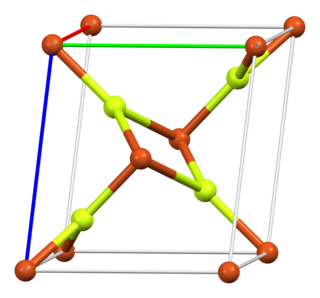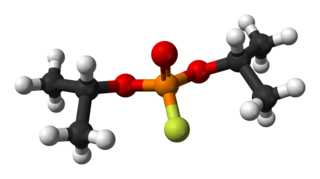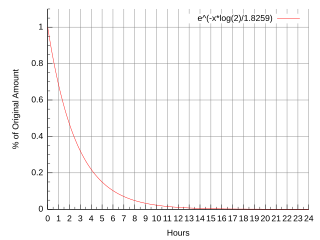
Sodium fluoroacetate, also known as compound 1080, is an organofluorine chemical compound with the chemical formula FCH2CO2Na. It is the sodium salt of fluoroacetic acid. It contains sodium cations Na+ and fluoroacetate anions FCH2CO−2. This colourless salt has a taste similar to that of table salt and is used as a rodenticide.

Bromobenzene is an aryl bromide and the simplest of the bromobenzenes, consisting of a benzene ring substituted with one bromine atom. Its chemical formula is C6H5Br. It is a colourless liquid although older samples can appear yellow. It is a reagent in organic synthesis.

[18F]Fluorodeoxyglucose (INN), or fluorodeoxyglucose F 18, also commonly called fluorodeoxyglucose and abbreviated [18F]FDG, 2-[18F]FDG or FDG, is a radiopharmaceutical, specifically a radiotracer, used in the medical imaging modality positron emission tomography (PET). Chemically, it is 2-deoxy-2-[18F]fluoro-D-glucose, a glucose analog, with the positron-emitting radionuclide fluorine-18 substituted for the normal hydroxyl group at the C-2 position in the glucose molecule.

Copper(II) fluoride is an inorganic compound with the chemical formula CuF2. The anhydrous form is a white, ionic, crystalline, hygroscopic salt with a distorted rutile-type crystal structure, similar to other fluorides of chemical formulae MF2 (where M is a metal). The dihydrate, CuF2·2H2O, is blue in colour.

Diisopropyl fluorophosphate (DFP) or Isoflurophate is an oily, colorless liquid with the chemical formula C6H14FO3P. It is used in medicine and as an organophosphorus insecticide. It is stable, but undergoes hydrolysis when subjected to moisture.

Fluoroacetic acid is a organofluorine compound with the chemical formula FCH2CO2H. It is a colorless solid that is noted for its relatively high toxicity. The conjugate base, fluoroacetate occurs naturally in at least 40 plants in Australia, Brazil, and Africa. It is one of only five known organofluorine-containing natural products.

Fluorine-18 (18F) is a fluorine radioisotope which is an important source of positrons. It has a mass of 18.0009380(6) u and its half-life is 109.771(20) minutes. It decays by positron emission 96.7% of the time and electron capture 3.3% of the time. Both modes of decay yield stable oxygen-18.
Organofluorine chemistry describes the chemistry of organofluorine compounds, organic compounds that contain a carbon–fluorine bond. Organofluorine compounds find diverse applications ranging from oil and water repellents to pharmaceuticals, refrigerants, and reagents in catalysis. In addition to these applications, some organofluorine compounds are pollutants because of their contributions to ozone depletion, global warming, bioaccumulation, and toxicity. The area of organofluorine chemistry often requires special techniques associated with the handling of fluorinating agents.

Diethylaminosulfur trifluoride (DAST) is the organosulfur compound with the formula Et2NSF3. This liquid is a fluorinating reagent used for the synthesis of organofluorine compounds. The compound is colourless; older samples assume an orange colour.
Fluorination with aminosulfuranes is a chemical reaction that transforms oxidized organic compounds into organofluorine compounds. Aminosulfuranes selectively exchange hydroxyl groups for fluorine, but are also capable of converting carbonyl groups, halides, silyl ethers, and other functionality into organofluorides.

Fluorine may interact with biological systems in the form of fluorine-containing compounds. Though elemental fluorine (F2) is very rare in everyday life, fluorine-containing compounds such as fluorite occur naturally as minerals. Naturally occurring organofluorine compounds are extremely rare. Man-made fluoride compounds are common and are used in medicines, pesticides, and materials. Twenty percent of all commercialized pharmaceuticals contain fluorine, including Lipitor and Prozac. In many contexts, fluorine-containing compounds are harmless or even beneficial to living organisms; in others, they are toxic.

4-Fluorobromobenzene is a mixed aryl halide (aryl fluoride and aryl bromide) with the formula C6H4BrF. It is a derivative of benzene, with a bromine atom bonded para to a fluorine atom. It has uses as a precursor to some pharmaceuticals, as an agrochemical intermediate, and in organic synthesis. It is a colorless liquid of low acute toxicity.
1,2-Difluoroethane is a saturated hydrofluorocarbon containing an atom of fluorine attached to each of two carbons atoms. The formula can be written CH2FCH2F. It is an isomer of 1,1-difluoroethane. It has a HFC name of HFC-152 with no letter suffix. When cooled to cryogenic temperatures it can have different conformers, gauche and trans. In the liquid form these are about equally abundant and easily interconvert. As a gas it is mostly the gauche form.

Methyl fluoroacetate (MFA) is an organic compound with the chemical formula FCH2CO2CH3. It is an extremely toxic methyl ester of fluoroacetic acid. It is a colorless, odorless liquid at room temperature. It is used as a laboratory chemical and as a rodenticide. Because of its extreme toxicity, MFA was studied for potential use as a chemical weapon.

Peter J. H. Scott FRSC CChem is a British and American chemist and radiochemist who is a professor of radiology, professor of pharmacology and professor of medicinal chemistry, as well as a core member of the Rogel Cancer Center at the University of Michigan in the United States. He is Chief of Nuclear Medicine and director of the University of Michigan Positron Emission Tomography (PET) Center, and runs a research group developing new radiochemistry methodology and novel PET radiotracers.

Fluoroethyl fluoroacetate, or more accurately 2-fluoroethyl fluoroacetate, is an organic compound with the chemical formula FCH2CO2CH2CH2F. It is the fluoroacetate ester of 2-fluoroethanol, or in other words, the 2-fluoroethyl ester of fluoroacetic acid. 2-Fluoroethyl fluoroacetate is two times more toxic than methyl fluoroacetate.

Fluoroaspirin is the fluoroacetate ester of salicylic acid. It is the fluoroacetate analog of aspirin. Like other fluoroacetate esters, fluoroaspirin is highly toxic.
4-Fluorobutanol is a chemical compound, a flammable colorless liquid which is a fluorinated alcohol. Like 2-fluoroethanol, it is highly toxic due to its ready metabolism to fluoroacetate.

2-Ethylhexyl fluoroacetate is an organic compound with the chemical formula FCH2CO2CH2CH(CH2CH3)CH2CH2CH2CH3. It is the fluoroacetate ester of 2-ethylhexanol, in other words, the 2-ethylhexyl ester of fluoroacetic acid. It can be produced by reaction of ethyl fluoroacetate with 2-ethylhexanol. 2-Ethylhexyl fluoroacetate is a liquid that is highly toxic by skin absorption.



















